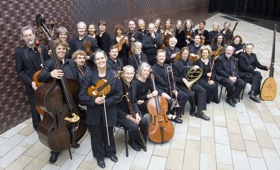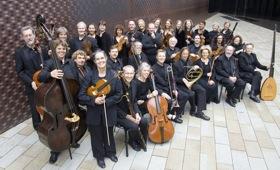The Philharmonia Baroque Orchestra hasn't been just a Baroque orchestra for a very long time; Haydn, Mozart, and the early Romantics are bread and butter to its seasons now. Still ... Brahms? From a self-described Baroque orchestra? The Philharmonia launched their Brahms foray on Thursday night at San Francisco's Herbst Theatre, a double bill of the composer's First Serenade for full orchestra (in D major, Op. 11) and his Violin Concerto (Op. 77, also D Major), with Viktoria Mullova as soloist.

Now, "period" orchestras have been playing Brahms for maybe 20 years now. But for PBO this represents a significant departure, planting the ensemble at least a generation later than anything I believe it has programmed before (2007's To Hell and Back excepted). If the results were mixed, it's understandable; for longtime Baroque players like PBO's core, Brahms simply isn't the familiar fare it is for the mass of classically trained players.
Much was splendid. The Serenade, in particular, is a work calculated to bring out all that's irresistible in McGegan's conducting — the boisterous energy, the humor, the glee. He was clearly having the time of his life, and the orchestra responded in kind. There was less flexibility of tempo than I'd have hoped, but McGegan's vivid sense of musical gesture and his orchestra's detailed, lightning-fast response to it remain as delightful as ever.
Nonetheless, this was new territory, and sometimes that was evident. There was a faintly "off" feeling about the style, comparable in its way to the slight stiltedness you get when a good "modern" orchestra attempts to play (say) Rameau. It's not blatantly unmusical, but the music's gestural style doesn't feel entirely comfortable and "lived-in."
That was particularly true, on Thursday night, with the string portamenti. In music this late, where most of the orchestral instruments are much more like their modern equivalents than they are in PBO's home turf, the key element of historical performance is style, rather than timbre. (See Jonathan Rhodes Lee's preview article for a first-rate overview of the issues.) And one of the aspects of later 19th-century style that we do know is that the general level of sliding from pitch to pitch was much higher than our own. If you are trying to play Brahms with some degree of historical accuracy, you're pretty well forced to readjust a few things — not least your sense of what is, and isn't, in musical good taste.
The Philharmonia strings did try, and to a considerable extent succeeded. There were places — the G-minor second Menuet for one — where the portamento achieved the kind of naturalness and grace that is its point, smoothing the notes into a long line and letting the phrases glide from arc to arc.
All the same, much of the time the effect felt calculated and vaguely uncomfortable, and also too tentative. I found myself wondering whether a good "modern" orchestra might not have been more successful in bringing the experiment off. "Modern" players don't slide in that way either, but they don't take musical hygiene (so to speak) to the lengths typical in historical performance of earlier music. Had the portamento level been anything like it should have been, historically speaking, I think a good part of PBO's regular audience would have been more than a little uncomfortable. There was little to discomfit them Thursday; what embarrassment there was seemed to be in the orchestra.
There was also quite a bit more dubious intonation than I am accustomed to hearing from Philharmonia. This is usually a string band with extraordinarily finicky ears; everyone is listening and adjusting all the time, which is one secret of its great transparency of sound. On Thursday, there was some unwanted fuzz in the mix, most noticeable when sections were playing in octaves. At the opening of the Violin Concerto, for example, the violas and cellos seemed unable to agree on the location of F-sharp. The trouble might have been simply the size of the band — 32 strings, about half again as large as PBO uses on a typical Classical set. Another contributing factor might have been the setup, a historical one that had the basses lined up against the back wall and separated from the other strings by the entire wind section.
The winds were in good form, apart from some most uncharacteristic sour playing from clarinetist Erich Hoeprich. Special praise to bassoonists Dennis Godburn and Andrew Schwartz, for the lovely, rich lines after the first-movement cadenza of the concerto, and to the four horns for their rasping romps in the outer movements of the Serenade.
Finding the Guts of the Violin Concerto
In the concerto, Mullova was naturally on firmer ground than her accompanists; the piece may be well off the right edge of PBO's musical map, but it's pretty much dead center on hers. It was a lithe, high-energy performance, (again) stiffer tempo-wise than I might have hoped, but finely shaped, and replete with thoughtful details of articulation and shadings of tone color. In the cadenza (by the concerto's dedicatee, Joseph Joachim) she was free, quirky, and mercurial, making much of the dynamic contrasts and messing playfully with the tempo.There are works that I still can't quite believe were written for people using gut E strings, and this is one of them. Mullova was not noticeably gentle on her top string. Yet not only did it survive the performance intact, it also "spoke" infallibly and easily throughout, even in the highest register. Her sound was, indeed, marvelously clean and clear throughout, and its range was wide: ineffably sweet where she wanted it to be, positively savage in other places. The torrent of trills in the first movement's development came like a physical shock.
Mullova was a lean sort of violinist long before she branched out into "period" playing. Perhaps part of the attraction of the "period" world for her is that here the kind of sound she has always favored is not something that has its pluses and minuses, but a clear asset. She sounded entirely at home, and not all that different from her "modern" self. Like the orchestra, she did use more portamento than is her wont, though more convincingly (to my ear) than her orchestral colleagues. And she resorted to natural harmonics in a couple of climactic places right before tutti sections in the first movement where any self-respecting "modern" virtuoso would have vibrated the note.
Will PBO continue with Brahms? I, for one, certainly hope so. Before this generation, the only musicians to tackle Brahms from the left side of the time axis (so to speak) were the ones who first played it. There's no way to replay that experiment. But gradually steeping in a new musical style with instincts, habits, and tastes formed by an older one is what produced the late-19th-century performance style in the first place — and also what produced Philharmonia's buoyant, witty, and highly inflected way with the Classical and early Romantic repertoire. Who knows what we'll get this time?

